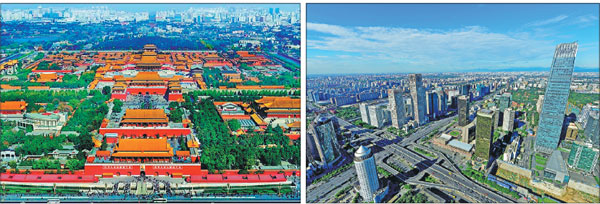Blueprint approval hands capital tools for an eco-friendly future
Beijing equipped to protect environment, control population and expand urban real estate
The central government's green light to Beijing's new development blueprint provides strong leadership for the future direction of the capital, according to a senior official.
Zhang Gong, executive vice-mayor of Beijing, made the remarks at a news conference on March 8 during the ongoing two sessions, an annual gathering of China's top legislative and political advisory bodies.
"After the Communist Party of China Central Committee and the State Council approved our new overall city development plan, we can envision a better future for Beijing," Zhang said.
It is the country's first megacity urban plan that seeks eco-friendly updates and transformation, with a focus on environmental protection and controls on population expansion and urban real estate development, he noted.
Like other overloaded metropolises in the world, Beijing has embraced the rapid pace of modernization yet faces common chronic problems, such as soaring increases in population, heavy traffic congestion, air pollution and a shortage of resources.
To address these issues, Beijing rolled out a draft regarding its new overall development plan in March 2017, open to feedback from the public.
Within a month, local authorities received more than 10,000 comments and opinions on it, with over 1 million words written about the plan.
After the central government gave the plan the green light, the official version was released in September 2017.
"It sets a schedule for the future construction of the city over the next 17 years and provides us a working plan," said a Beijing government official.
Different from its previous version, the new plan focuses on the balanced development of urban and rural areas and of Beijing's southern and northern regions. New construction projects will be added to the less-developed southern region, compared with the north.
Serving the Beijing-Tianjin-Hebei coordinated development strategy is another feature of the new plan, which takes into account the deployment of resources for the benefit of integrated regional development, the official said.
As with previous plans there will be a focus on downtown Beijing and its sub-center Tongzhou district, however it also covers the development of Xiong'an New Area in Baoding, in neighboring Hebei province.
The new plan will continue to foster Beijing's Zhongguancun Science City, Huairou Science City, Future Science City and the Beijing Economic Technological Development Area - all of which are maturing into major sources of innovation.
Beijing's transition to a more eco-friendly growth model has resulted in a continuous drop in the city's energy consumption and growing influence in technological innovation over the past few years, local officials said.
This innovation has resulted in half of Beijing's total technological deals signed with more than 350 other Chinese cities, expanding the capital's influence in innovation throughout the country.
In 2017, a total of 78 research achievements from Beijing won awards at an annual national rewards conference on science and technology, accounting for 36 percent of winners for the year.
British scientific journal Nature ranked Beijing top of 500 cities worldwide in terms of research output in 2017.
|
From left: An aerial view of the Tian’anmen Gate and the Forbidden City, landmarks in Beijing. The city’s cultural heritage provides rich pickings for developing the local creative industry. Ma Wenxiao / For China Daily Beijing is fostering its high-tech businesses to help them gather pace.Provided To China Daily |

(China Daily 03/16/2018 page12)















